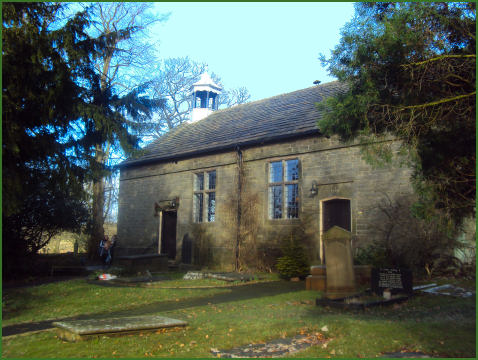Rivington
OS Grid ref:- SD626144
The small village of Rivington is situated at the foot of Rivington Pike on the high moorland of the West Pennine Moors and lies about 6 miles to the southeast of Chorley.
Rivington is an ancient village, dating from an early settlement of around 620-650 AD. The origin of the village's name is unclear, but it is made up of three elements. The first element Riv- is believed to derive from the Anglo-Saxon 'hreof' meaning rough. The second element -ing- usually referred to a place belonging to a person. The last part of the name comes from the Old English word 'tun' meaning a farmstead or settlement. The settlement of the rough hill (this probably refers to the nearby windswept Winter Hill.
Rivington Village Green and the Unitarian Chapel


In the early middle ages the village became home to a junior branch of the Pilkington family. In 1212 Alexander de Pilkington held six oxgangs of land in thanage, the majority of land in the Manor of Rivington. The first recorded mention of Rivington Hall occured in 1477, when in that year it was extended by Robert Pilkington, who inherited the Rivington estates in 1476. It was then a wattle and daub manor house, Robert Pilkington employed William Holden to add a hall, cross chambers and two large windows.
Following the death of the last Pilkington owner, the estate was purchased in 1611 by relatives Robert Lever and Thomas Breres, the Breres became resident at the hall. The hall was rebuilt in stone at the end of the seventeenth century. In 1729 John Andrews bought the Breres' share of the estate and was responsible for the building the Pike Tower in 1733. The hall was again rebuilt with a red brick Georgian frontage by Robert Andrews in 1774 incorporating some of the older stone building. After passing through several further families the 2,100-acre (8.5 km2) estate was sold to to William Lever, Lord Leverhulme, owner of what is now Unilever, in 1900.
The area surrounding the village is a conservation zone. The village green is believed to be a remnant of a former Anglo-Saxon common. Overlooking the green is the Unitarian chapel which dates back to 1703. It contains a grand monument to the family of Hugh Willoughby, 15th Baron Willoughby of Parham. The foundations of a building that was perhaps a water mill or the manor corn mill are visible opposite Mill Hill Cottages.
Great House Information Centre, just off Rivington Lane, in Lever Park boasts superb water facilities and is open throughout the year offering visitors a variety of exhibitions on the local and natural history of the area and ideas for other places to visit in the West Pennine Moors. Construction dates for the barn are speculated between 811 A.D. and 1300 A.D., it was renovated in 1702. The roof is spectacular with an internal oak framework.
To the east of the village is Rivington Pike which rises to 1,191 feet (363 metres) high is the most westerly high point of Winter Hill in the West Pennine Moors. To the west of the village is the wide shallow valley containing the Anglezarke, Upper and Lower Rivington reservoirs.
Rivington Country Park has woodland paths and moor side walks, which afford spectacular hilltop views of the surrounding countryside.
Nearby Places of Interest
Tiger's Clough Waterfall situated on the River Douglas in a shady ravine on the Knollshaw Estate near Rivington.
Rufford Old Hall-Timber framed hall at Rufford near Ormskirk which dates back to the sixteenth century and is one of Lancashire's finest Tudor buildings.
Martin Mere -seasonally flooded wetlands attracts tens of thousands of migratory geese and wetlands birds making it one of the finest birding locations in the country.
